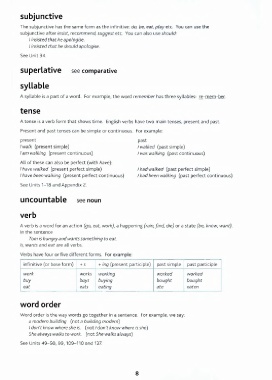Page 399 - murphy_raymond_english_grammar_in_use 1
P. 399
subjunctive
The subjunctive has the same form as the infinitive: do, be, eat, play etc. You can use the
subjunctive after insist, recommend, suggest etc. You can also use should:
I insisted that he apologise.
I insisted that he should apologise.
See Unit 34.
superlative see comparative
syllable
A syllable is a part of a word. For example, the word remember has three syllables: re-mem-ber.
tense
A tense is a verb form that shows time. English verbs have two main tenses, present and past.
Present and past tenses can be simple or continuous, For example:
present past
I walk (present simple) I walked (past simple)
I am walking (present continuous) I was walking (past continuous)
All of these can also be perfect (with have):
I have walked (present perfect simple) I had walked (past perfect simple)
I have been walking (present perfect continuous) I had been walking (past perfect continuous)
See Units 1-18 and Appendix Z.
uncountable see noun
verb
A verb is a word for an action (go, eat, work), a happening (rain, find, die) or a state (be, know, want).
In the sentence
Tom is hungry and wants something to eat.
is, wants and eat are all verbs.
Verbs have four or five different forms. For example:
infinitive (or base form) + 5 + ing (present participle) past simple past participle
work works working worked worked
buy buys buying bought bought
eat eats eating ate eaten
word order
Word order is the way words go together in a sentence. For example, we say:
a modern building (not a building modern)
I don't know where she is. (not I don't know where is she)
She always walks to work, (not She walks always)
See Units 49-50, 99, 109-110 and 137.
8

